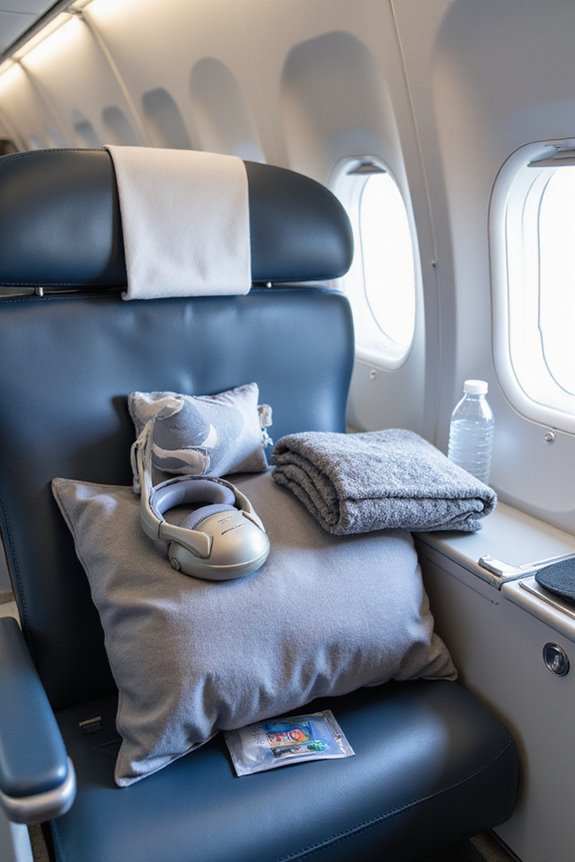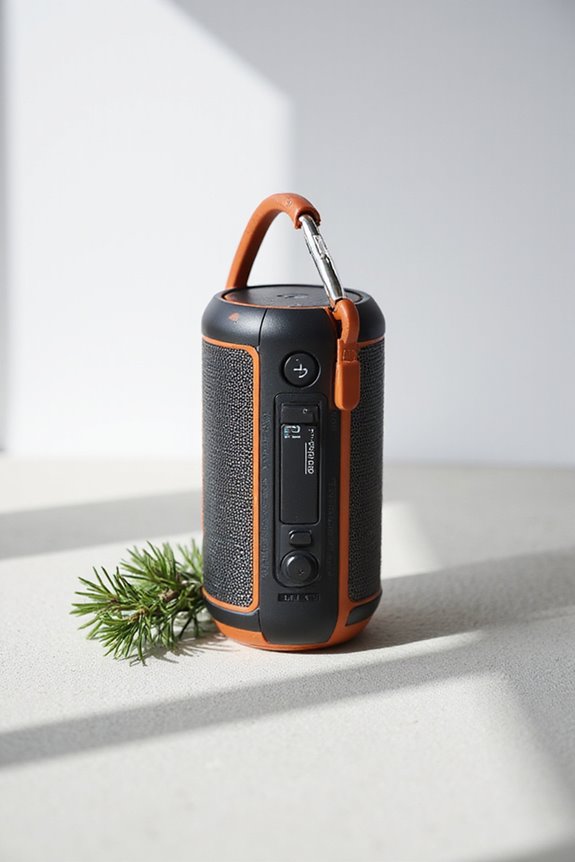To stay comfortable on long flights, opt for an aisle seat where you can stretch your legs. Wear loose, breathable clothing—think soft cotton and comfy shoes. Hydrate often, but skip the cocktails; fruit snacks work wonders. For sleep, consider melatonin and a cozy travel pillow. Don’t forget the hygiene essentials like hand sanitizer. It can feel like a marathon in the sky, but with smart choices and a little planning, you’ll navigate those hours like a pro. There’s a lot more to make your journey enjoyable!
Key Takeaways
- Choose a spacious aisle seat and maintain good posture with lumbar support to enhance comfort during the flight.
- Wear loose-fitting, breathable clothing and comfy slip-on shoes to ensure freedom of movement and ease during security checks.
- Stay hydrated by sipping water consistently and packing nutritious snacks for sustained energy and hydration throughout the journey.
- Stand or perform in-seat exercises every hour to promote circulation and alleviate discomfort during long flights.
- Use sleep aids like melatonin and relaxation techniques to improve sleep quality, especially on longer journeys.
Seating and Movement Strategies
When it comes to surviving long flights, the right seating and movement strategies can make all the difference, especially if you want to arrive at your destination feeling somewhat refreshed instead of like a pretzel. Choosing the best seat dimensions—like opting for a spacious aisle seat—can enhance comfort levels considerably. Meanwhile, maintaining good posture techniques, like keeping an upright position with back support, can alleviate lower back pain. Incorporating movement strategies, such as standing every hour or doing in-seat exercises like ankle circles, promotes better circulation. Don’t forget accessory use! A portable lumbar support or travel pillow can work wonders. By combining these elements, travelers can create a more pleasant and comfortable flying experience, leaving discomfort at the gate.
Clothing Recommendations
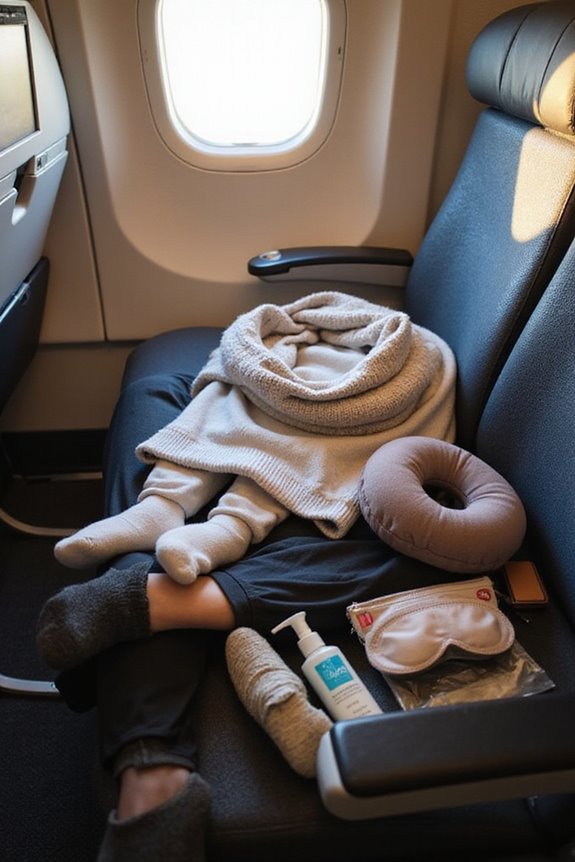
Finding the right clothing for a long flight can feel like a quest for the holy grail of comfort. The key lies in smart fabric choices; breathable options like cotton or moisture-wicking materials keep the air flowing and your skin dry. Loose-fitting outfit combinations are essential too; think elastic waistbands and stretchy pants that let you move freely. Imagine slipping into soft joggers paired with a cozy cardigan—perfect for those unpredictable cabin temperatures! Avoid tight jeans or anything with zippers that squeeze during turbulence. Layering is your friend, so opt for lightweight pieces that are easy to adjust. And don’t forget comfy slip-on shoes; they make security checks a breeze while keeping your feet happy during the flight!
Hydration and Nutrition
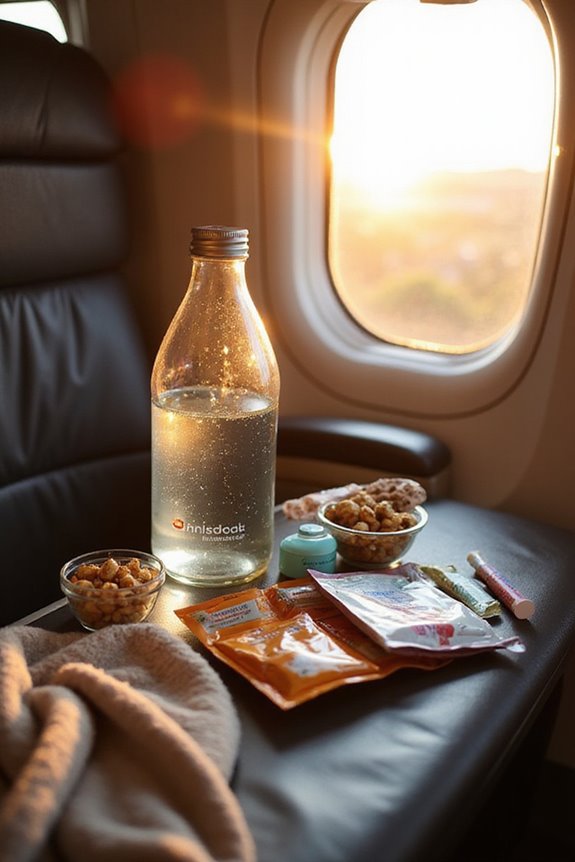
How can travelers keep their spirits high and their bodies well-hydrated during those marathon flights? Staying hydrated is essential, especially with that dry cabin air sucking moisture away faster than a vacuum. Hydration tips like sipping on water regularly, rather than guzzling it all at once, can make a huge difference. For a tasty twist, pack some nutritious snacks like juicy fruits or electrolyte-rich treats to keep energy levels up and hydration steady. Avoid those tempting cocktails and excessive caffeine, which can leave you feeling parched. Instead, opt for nonalcoholic, low-sodium drinks to help maintain fluid balance. Remember, a refillable water bottle is your best friend—sip away to stay refreshed and ready for whatever adventures await after landing!
Sleep and Rest Aids

After quenching that thirst during a long flight, the next challenge is tackling the delicate dance of sleep and rest. Many travelers turn to sleep supplements, like melatonin, hoping to catch some Zs. While melatonin can improve sleep quality—especially after eastward flights—it’s not a magic pill. It’s best used alongside relaxation techniques, such as adjusting your sleep schedule a few days prior to departure and using bright light strategically. However, travelers should be cautious, as prescription and OTC sleep aids can come with side effects like grogginess or dehydration. A thoughtful approach, blending supplements and behavioral strategies, may just lead to a restful journey, transforming those long hours into peaceful moments instead of a restless struggle against the seatbelt.
Health and Hygiene Measures
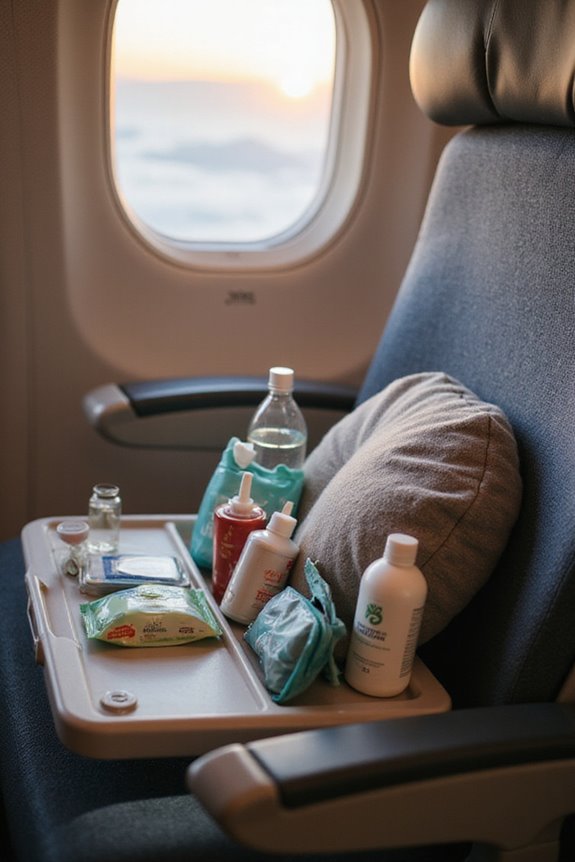
While commencing on a long flight, keeping one’s health and hygiene in check becomes just as essential as packing snacks and a good book. Airlines have ramped up their cleaning protocols, ensuring high-touch surfaces like tray tables and seat belts are frequently disinfected. Passengers can spot visible cleaning efforts, which is reassuring. Health screenings, including temperature checks, are common at airports, helping to catch any potential illness before boarding. Travelers are encouraged to practice personal hygiene, such as using hand sanitizer often and covering sneezes. While social distancing may be tricky on a plane, boarding by rows and limited movement helps. All these measures aim to create a safer environment, making long flights a bit more comfortable for everyone.
Preparation and Practical Tips
Preparing for a long flight can feel like gearing up for an expedition, especially when one considers all the little details that can make a world of difference in comfort. Arriving at the airport at least three hours before departure reduces stress and gives ample time for check-in and security. Next, don’t underestimate the power of seat selection; choosing an aisle seat can enhance mobility, while extra legroom options can feel like a tiny slice of heaven. Wearing loose, layered clothing helps combat unpredictable cabin temperatures, making it easier to stay cozy. And let’s not forget hydration—packing personal snacks and a water bottle can prevent overpriced in-flight meals and keep that energy up. With these tips in hand, travelers can commence their journey feeling prepared and comfortable.
In-Flight Activities for Comfort
Long flights can sometimes feel like an endurance test, but with the right in-flight activities, they can turn into a surprisingly enjoyable experience. Engaging in creative writing can transform idle time into a productive outlet, whether jotting down postcards or planning future adventures. Meanwhile, in-flight entertainment options like movies, documentaries, or podcasts keep boredom at bay. Don’t forget to incorporate some movement! Simple exercises like ankle rolls or walking the aisle every hour boost circulation and reduce stiffness. Adult coloring books offer a relaxing escape too, perfect for unwinding. Finally, staying hydrated is key, so frequent bathroom trips not only help with hydration but also encourage movement, making the journey more comfortable and enjoyable.
Managing Jet Lag Effectively
After spending hours in the air, surrounded by snacks and fellow travelers, there’s nothing quite like stepping off the plane and realizing your body has no idea what time it is. To tackle jet lag effectively, strategic light exposure is essential. Soaking in bright light during the day helps adjust your internal clock to your destination’s time zone. Meanwhile, melatonin timing plays a pivotal role; taking melatonin in the afternoon can advance your circadian rhythm, while morning doses can help delay it. Pre-travel preparations, like adjusting sleep schedules and minimizing stress, also help. Once you arrive, outdoor exercise and hydration can work wonders. Remember, staying clear of heavy meals and caffeine can improve your sleep quality, easing your shift into local time.
Frequently Asked Questions
Can I Use Electronic Devices During the Flight?
In the sky’s vast expanse, electronic devices dance at the fingertips. Laptop usage is permitted above 10,000 feet, while phone etiquette demands silence. Respectful use guarantees harmony among passengers as they journey through clouds.
What Should I Do if I Feel Claustrophobic?
When feeling claustrophobic, individuals can benefit from practicing breathing exercises and relaxation techniques. These methods help alleviate anxiety, enabling a more comfortable experience in confined spaces, ultimately reducing the intensity of panic responses.
Are There Any In-Flight Entertainment Options Available?
Ironically, while one might expect boredom at 30,000 feet, in-flight movies and diverse audio options guarantee passengers are entertained. Choices range from blockbuster films to curated playlists, transforming the flying experience into a delightful escape.
How Can I Deal With a Crying Baby on Board?
Dealing with a crying baby on board can be challenging. Passengers may find relief through baby distractions, while noise-canceling headphones can help mitigate the sound, creating a more peaceful environment amidst the distressing situation.
What if My Flight Is Delayed or Canceled?
When facing a flight delay or cancellation, passengers should explore flight alternatives and consider travel insurance for coverage. Staying informed about rights and options can considerably alleviate the stress of disrupted travel plans.

